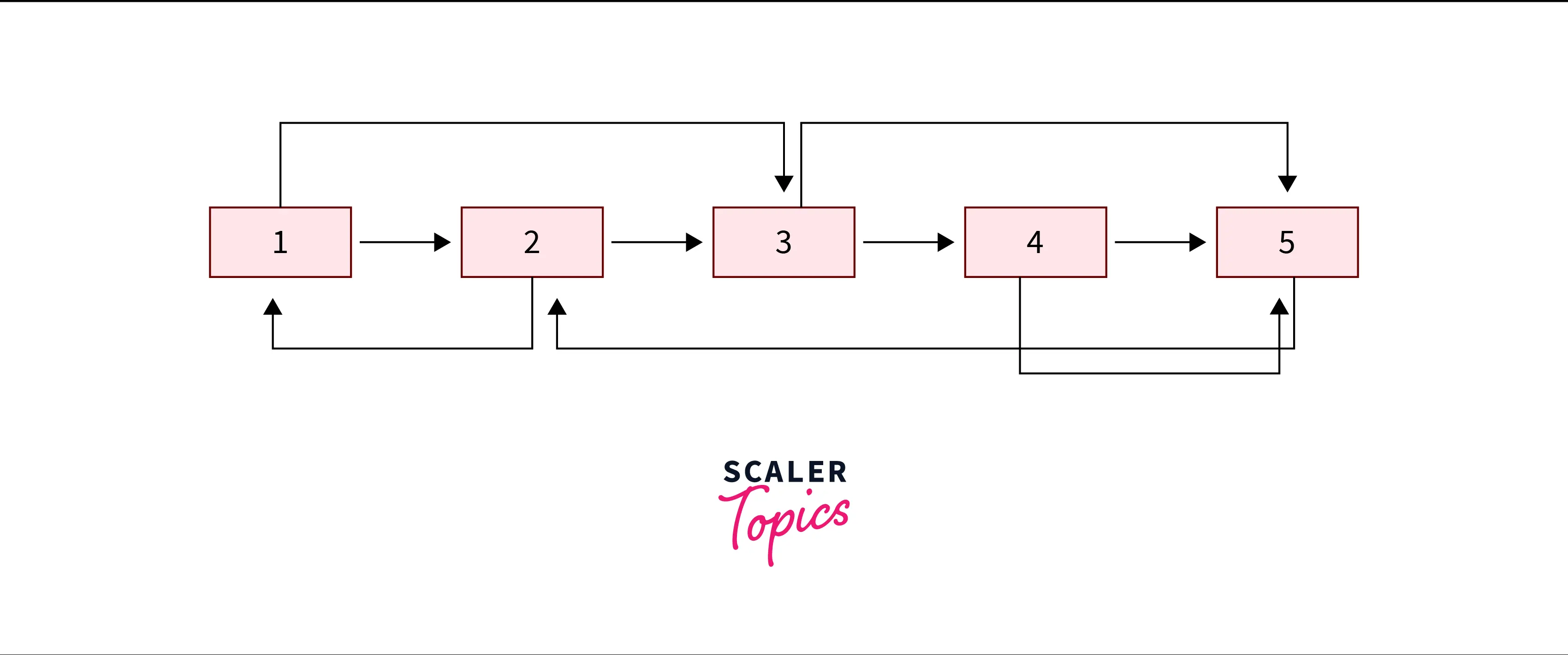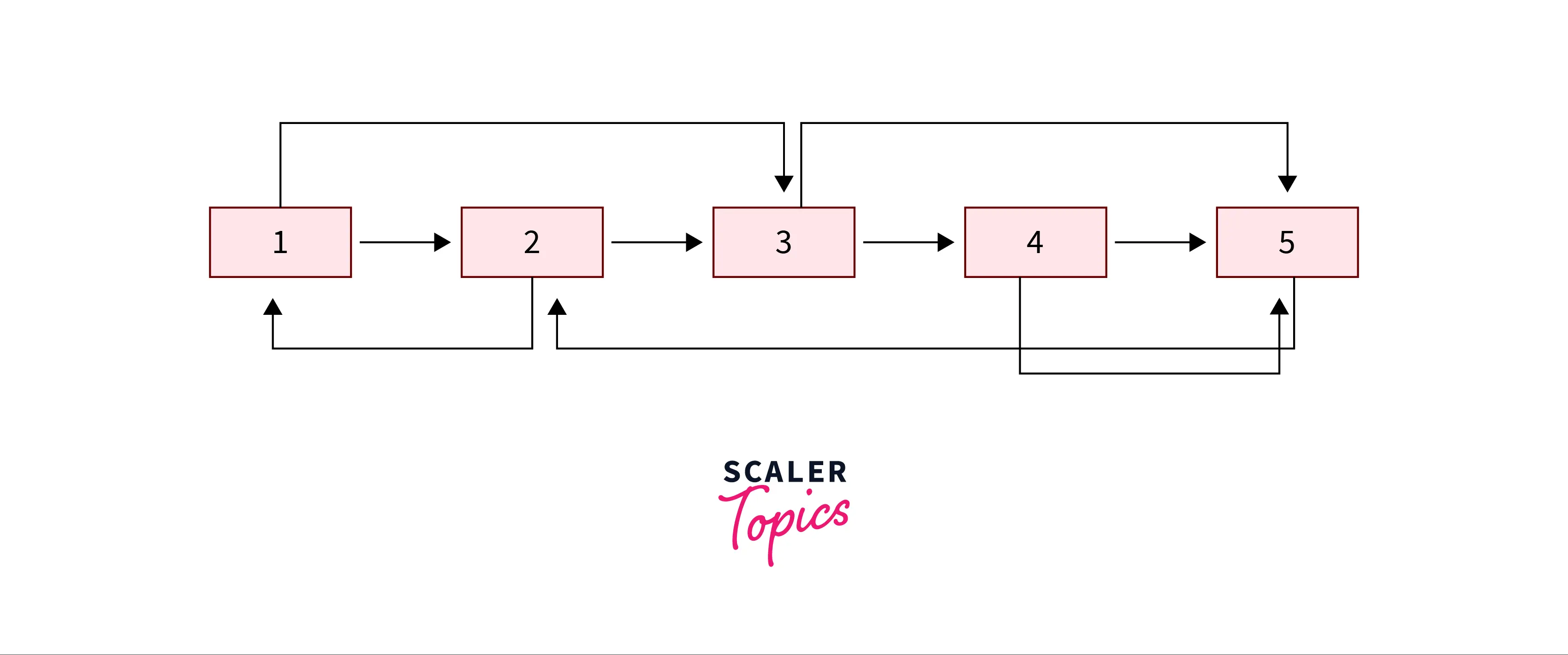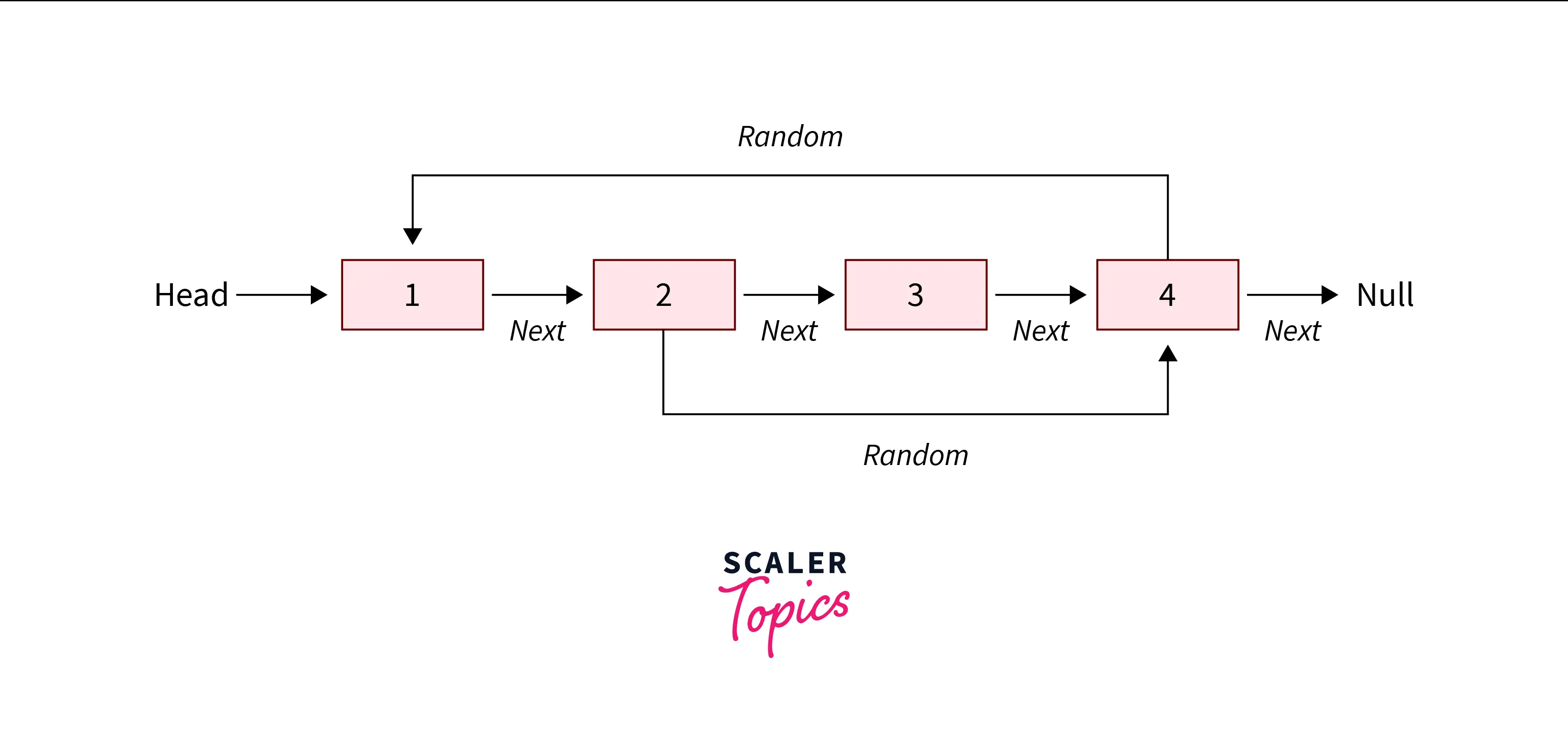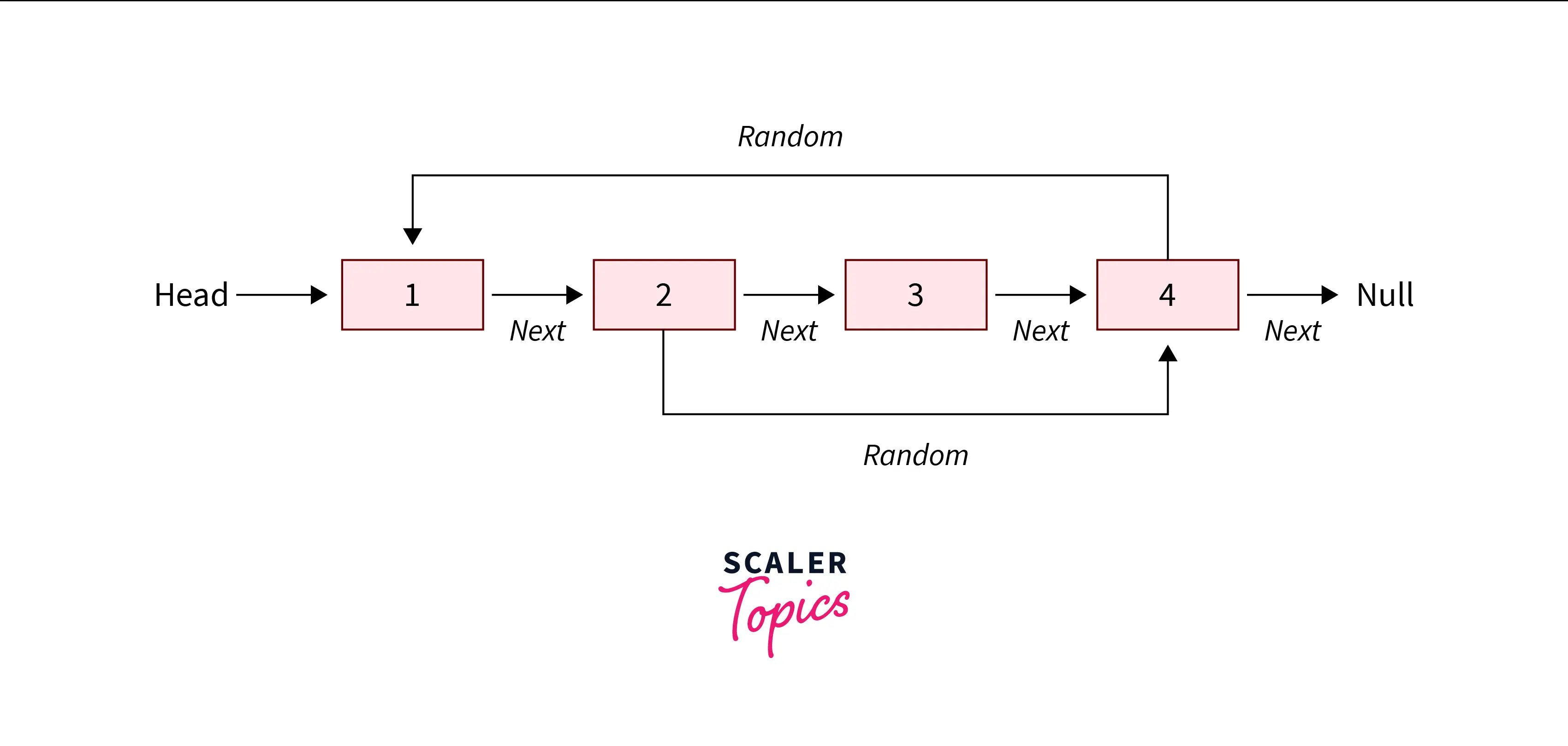Problem Statement
A linked list of length n is provided. Every node also has a random pointer that could refer to any node in the list or to null.
The list should be built as a deep copy (A copy of an object that does not share the same references as the source object from which it was copied is said to be a deep copy of that object). The deep copy should be made up of exactly n new nodes, each of which has the value set to that of the corresponding node from the original copy. The next and random pointer of the new nodes should point to new nodes in the copied list.
Example
Input:

Output:

Explanation: Copy of the linked list is being created with next and random pointers.
Input:

Output:

Explanation: Copy of the linked list is being created with next and random pointers.
Constraints
1<=length of linked list<=10000ts
1<=Data of Node<=1000
Approach 1 – Uses O(n) Extra Space
To clone a linked list with next and random pointer, This approach first saves the next and arbitrary pointers (from the original list) in an array before making a copy of the original Linked List.
- Go over the original linked list and create a data duplicate of it.
- Make an array containing the next and random pointer values for each node of the original linked list.
- Traverse the original linked list and using the values stored in the array adjust the next and random reference of cloned linked list nodes.
Python Implementation
class Node:
def __init__(self, data):
self.data = data
self.next = None
self.random = None
def cloneLinkedList(head):
# Initialize a temp pointer
temp = head
# Making the array to store the data
arr=[]
# Making the copy of the linked list
while temp is not None:
new_node = Node(temp.data)
# appending the values to arr
arr.append([new_node, temp.next, temp.random])
temp = temp.next
temp = head
i=0
# Traversing the head and adjusting the pointers
while temp is not None:
new_node = arr[i][0]
new_node.next = arr[i][1]
new_node.random = arr[i][2]
temp = temp.next
i+=1
# Return the of the clone list.
return arr[0][0]
# making linked list
head = Node(1)
head.next = Node(2)
head.next.next = Node(3)
# Making random pointers
head.random = head.next.next
head.next.random = head
head.next.next.random = head.next
# Printing the linked list values
temp = head
print("Original Linked List is:")
while(temp):
print("data:",temp.data, "random:",temp.random.data)
temp = temp.next
# Printing the Cloned linked list values
temp = cloneLinkedList(head)
print("Cloned Linked List is:")
while(temp):
print("data:",temp.data, "random:",temp.random.data)
temp = temp.nextC++ Implementation
#include<bits/stdc++.h>
using namespace std;
// Linked list Definition
class Node{
public:
int data;
// Next and random pointer
Node *next, *random;
Node(int data)
{
this->data = data;
this->next = this->random = NULL;
}
};
// linked list class
class LinkedList{
public:
Node *head;
LinkedList(Node *head){
this->head = head;
}
void push(int data){
Node *node = new Node(data);
node->next = head;
head = node;
}
// Method to print the list.
void print(){
Node *temp = head;
while (temp != NULL)
{
Node *random = temp->random;
int randomData = (random != NULL)?
random->data: -1;
cout << "data: " << temp->data << " ";
cout << "random: " << randomData << endl;
temp = temp->next;
}
cout << endl;
}
LinkedList* cloneLinkedList(){
// Initialize a temp pointer
Node *temp = head;
Node *newNode = NULL;
// Make an array to store the data
vector<vector<Node*>> arr;
// Making the copy of the linked list
while (temp != NULL){
newNode = new Node(temp->data);
vector<Node*> v1;
v1.push_back(newNode);
v1.push_back(temp->next);
v1.push_back(temp->random);
arr.push_back(v1);
temp = temp->next;
}
temp = head;
// Traversing the head and adjusting the pointer
int i=0;
while (temp != NULL){
newNode = arr[i][0];
newNode->next = arr[i][1];
newNode->random = arr[i][2];
temp = temp->next;
i+=1;
}
// Return the head of cloned list
return new LinkedList(arr[0][0]);
}
};
// driver code
int main(){
// Making a linked list
LinkedList *mylist = new LinkedList(new Node(1));
mylist->push(2);
mylist->push(3);
mylist->head->random = mylist->head->next->next;
mylist->head->next->random = mylist->head;
mylist->head->next->next->random = mylist->head->next;
// Cloning the linked list
LinkedList *clone = mylist->cloneLinkedList();
cout << "Original linked list is:\n";
mylist->print();
cout << "\nCloned linked list is:\n";
clone->print();
}Java Implementation
import java.util.ArrayList;
import java.util.Map;
// Linked list Definition
class Node{
int data;
// Next and random pointer
Node next, random;
public Node(int data){
this.data = data;
this.next = this.random = null;
}
}
// linked list class
class LinkedList{
Node head;
public LinkedList(Node head){
this.head = head;
}
public void push(int data){
Node node = new Node(data);
node.next = this.head;
this.head = node;
}
void print(){
Node temp = head;
while (temp != null){
Node random = temp.random;
int randomData = (random != null)? random.data: -1;
System.out.println("data: " + temp.data + " random: "+ randomData);
temp = temp.next;
}
}
public LinkedList cloneList(){
// Initialize a temp pointer
Node temp = this.head;
Node newNode = null;
// Map<Node, Node> hashMap = new HashMap<Node, Node>();
ArrayList<ArrayList<Node>> arr = new ArrayList<ArrayList<Node>>();
// Making the copy of the linked list
while (temp != null){
newNode = new Node(temp.data);
ArrayList<Node> a1 = new ArrayList<Node>();
a1.add(newNode);
a1.add(temp.next);
a1.add(temp.random);
arr.add(a1);
// hashMap.put(temp, newNode);
temp = temp.next;
}
temp = this.head;
// Traversing the head and adjusting the pointer
int i=0;
ArrayList<Node> t = new ArrayList<Node>();
while (temp != null){
t = arr.get(i);
newNode = t.get(0);
newNode.next = t.get(1);
newNode.random = t.get(2);
temp = temp.next;
i+=1;
}
//return the head reference of the clone list.
t = arr.get(0);
return new LinkedList(t.get(0));
}
}
// Driver Class
class Main{
public static void main(String[] args){
LinkedList list = new LinkedList(new Node(1));
list.push(2);
list.push(3);
list.head.random = list.head.next.next;
list.head.next.random = list.head;
list.head.next.next.random = list.head.next;
// Cloning the linked list
LinkedList clone = list.cloneList();
// Printint the linked list.
System.out.println("Original linked list is:");
list.print();
System.out.println("\nCloned linked list is:");
clone.print();
}
}Output:
Original Linked List is:
data: 1 random: 3
data: 2 random: 1
data: 3 random: 2
Cloned Linked List is:
data: 1 random: 3
data: 2 random: 1
data: 3 random: 2Complexity Analysis
Time Complexity: O(N) => linked list has been traversed 2 times, so linear time is taken for this approach.
Space Complexity: O(N) => N space for storing N nodes in an array.
Approach 2 – Uses Constant Extra Space
To clone a linked list with next and random pointer, We’ll be implementing an algorithm that will require no extra space, lets see the algorithm for the same:
- In this approach, we will be using the approach of interweaving of nodes.
- In the original Linked List, make a copy of node 1 and place it between node 1 and 2, then make a copy of node 2 and place it between node 2 and 3. Continue by adding the duplicate of N after the Nth node.
- Now copy the random pointers in the interweaved nodes.
- After that, retrieve both the original and copied linked lists by rearranging the pointers
Python Implementation
class Node:
def __init__(self, data):
self.data = data
self.next = None
self.random = None
def cloneLinkedList(head):
# Initializing a temp pointer
temp = head
# Interweaving the copy of nodes
while(temp):
node = Node(temp.data)
node.next = temp.next
temp.next = node
temp = temp.next.next
# Initializing a temp pointer again
temp = head
# Adjusting the random pointers of copied values
while(temp):
if(temp.random):
temp.next.random = temp.random.next
temp = temp.next.next
# Initializing a temp pointer again
temp = head
# Initializing head of the clone value
clone = temp.next
# separating both the lists
while(temp.next):
a = temp.next
temp.next = temp.next.next
temp = a
return clone
# making linked list
head = Node(1)
head.next = Node(2)
head.next.next = Node(3)
# Making random pointers
head.random = head.next.next
head.next.random = head
head.next.next.random = head.next
# Printing the linked list values
temp = head
print("Original Linked List is:")
while(temp):
print("data:",temp.data, "random:",temp.random.data)
temp = temp.next
# Printing the Cloned linked list values
temp = cloneLinkedList(head)
print()
print("Cloned Linked List is:")
while(temp):
print("data:",temp.data, "random:",temp.random.data)
temp = temp.nextC++ Implementation
#include <bits/stdc++.h>
using namespace std;
struct Node{
int data;
Node *next,*random;
Node(int x){
data = x;
next = random = NULL;
}
};
void print(Node *start){
Node *ptr = start;
while (ptr){
cout << "data: " << ptr->data << " random: "<< ptr->random->data << endl;
ptr = ptr->next;
}
}
Node* cloneLinkedList(Node *head){
// Initialize a temp pointer
Node* prev = head, *temp;
// Interweaving the copy of nodes
while (prev){
temp = prev->next;
// Inserting node
prev->next = new Node(prev->data);
prev->next->next = temp;
prev = temp;
}
// Initializing a temp pointer again
temp = head;
// Adjusting the random pointers of copied values
while (temp){
if(temp->next)
temp->next->random = temp->random ?
temp->random->next : temp->random;
temp = temp->next?temp->next->next:temp->next;
}
// Initializing a temp pointer again
temp = head;
Node* clone = head->next;
// Initializing head of the clone list
Node* cloneHead = clone;
// separating both the lists
while (temp && clone){
temp->next = temp->next? temp->next->next : temp->next;
clone->next = clone->next?clone->next->next:clone->next;
temp = temp->next;
clone = clone->next;
}
return cloneHead;
}
// Driver code
int main(){
Node* head = new Node(1);
head->next = new Node(2);
head->next->next = new Node(3);
head->random = head->next->next;
head->next->random = head;
head->next->next->random = head->next;
cout << "Original Linked List is: \n";
print(head);
cout << "\nCloned Linked List is: \n";
Node *cloned_list = cloneLinkedList(head);
print(cloned_list);
return 0;
}Java Implementation
class Code {
static class Node {
int data;
Node next, random;
Node(int x){
data = x;
next = random = null;
}
}
static void print(Node start){
Node ptr = start;
while (ptr != null) {
System.out.println("data: " + ptr.data + " random: "+ ptr.random.data);
ptr = ptr.next;
}
}
static Node cloneList(Node head){
// Initialize a temp pointer
Node prev = head, temp = null;
// Interweaving the copy of nodes
while (prev != null) {
temp = prev.next;
// Inserting node
prev.next = new Node(prev.data);
prev.next.next = temp;
prev = temp;
}
// Initializing a temp pointer again
temp = head;
// Adjusting the random pointers of copied values
while (temp != null) {
if (temp.next != null)
temp.next.random = (temp.random != null) ? temp.random.next : temp.random;
temp = temp.next.next;
}
// Initializing a temp pointer again
temp = head;
Node clone = head.next;
// Initializing head of the clone list
Node cloneHead = clone;
// separating both the lists
while (temp != null) {
temp.next =temp.next.next;
clone.next = (clone.next != null) ? clone.next.next : clone.next;
temp = temp.next;
clone = clone.next;
}
return cloneHead;
}
// Driver code
public static void main(String[] args){
Node head = new Node(1);
head.next = new Node(2);
head.next.next = new Node(3);
head.random = head.next.next;
head.next.random = head;
head.next.next.random = head.next;
System.out.println("Original Linked List is: ");
print(head);
System.out.println("Cloned Linked List is: ");
Node cloned_list = cloneList(head);
print(cloned_list);
}
}Output:
Original Linked List is:
data: 1 random: 3
data: 2 random: 1
data: 3 random: 2
Cloned Linked List is:
data: 1 random: 3
data: 2 random: 1
data: 3 random: 2Complexity Analysis
Time Complexity: O(N) => linked list has been traversed 3 times, so linear time is taken for this approach.
Space Complexity: O(1) => No Extra space is needed in this approach.
Approach 3 – Using Hashing
The idea for this approach is hashing, lets see the algorithm for the same:
- Go over the original linked list and create a data duplicate of it.
- Make a hash map of key value pair with original linked list node and copied linked list node to store both the nodes.
- Traverse the original linked list and using the values stored in hash map adjust the next and random reference of cloned linked list nodes.
Python Implementation
class Node:
def __init__(self, data):
self.data = data
self.next = None
self.random = None
def cloneLinkedList(head):
# Initialize a temp pointer
temp = head
# Make a dictionary to store the data
hashMap = {}
# Making the copy of the linked list
while temp is not None:
new_node = Node(temp.data)
hashMap[temp] = new_node
temp = temp.next
temp = head
# Traversing the head and adjusting the pointers
while temp is not None:
new_node = hashMap.get(temp)
new_node.next = hashMap.get(temp.next)
new_node.random = hashMap.get(temp.random)
temp = temp.next
# Return the of the clone list.
return hashMap[head]
# making linked list
head = Node(1)
head.next = Node(2)
head.next.next = Node(3)
# Making random pointers
head.random = head.next.next
head.next.random = head
head.next.next.random = head.next
# Printing the linked list values
temp = head
print("Original Linked List is:")
while(temp):
print("data:",temp.data, "random:",temp.random.data)
temp = temp.next
# Printing the Cloned linked list values
temp = cloneLinkedList(head)
print()
print("Cloned Linked List is:")
while(temp):
print("data:",temp.data, "random:",temp.random.data)
temp = temp.nextC++ implementation
#include<bits/stdc++.h>
using namespace std;
// Linked list Definition
class Node{
public:
int data;
// Next and random pointer
Node *next, *random;
Node(int data){
this->data = data;
this->next = this->random = NULL;
}
};
// linked list class
class LinkedList{
public:
Node *head;
LinkedList(Node *head){
this->head = head;
}
void push(int data){
Node *node = new Node(data);
node->next = head;
head = node;
}
// Method to print the list.
void print(){
Node *temp = head;
while (temp != NULL){
Node *random = temp->random;
int randomData = (random != NULL)?
random->data: -1;
cout << "data: " << temp->data << " ";
cout << "random: " << randomData << endl;
temp = temp->next;
}
cout << endl;
}
LinkedList* cloneLinkedList(){
// Initialize a temp pointer
Node *temp = head;
Node *newNode = NULL;
// Make a map to store the data
unordered_map<Node*, Node*> hashMap;
// Making the copy of the linked list
while (temp != NULL){
newNode = new Node(temp->data);
hashMap[temp] = newNode;
temp = temp->next;
}
temp = head;
// Traversing the head and adjusting the pointer
while (temp != NULL){
newNode = hashMap[temp];
newNode->next = hashMap[temp->next];
newNode->random = hashMap[temp->random];
temp = temp->next;
}
// Return the head of cloned list
return new LinkedList(hashMap[head]);
}
};
// driver code
int main(){
// Making a linked list
LinkedList *mylist = new LinkedList(new Node(1));
mylist->push(2);
mylist->push(3);
mylist->head->random = mylist->head->next->next;
mylist->head->next->random = mylist->head;
mylist->head->next->next->random = mylist->head->next;
// Cloning the linked list
LinkedList *clone = mylist->cloneLinkedList();
cout << "Original linked list is:\n";
mylist->print();
cout << "\nCloned linked list is:\n";
clone->print();
}Java Implementation
import java.util.HashMap;
import java.util.Map;
// Linked list Definition
class Node{
int data;
// Next and random pointer
Node next, random;
public Node(int data){
this.data = data;
this.next = this.random = null;
}
}
// linked list class
class LinkedList{
Node head;
public LinkedList(Node head){
this.head = head;
}
public void push(int data){
Node node = new Node(data);
node.next = this.head;
this.head = node;
}
void print(){
Node temp = head;
while (temp != null){
Node random = temp.random;
int randomData = (random != null)? random.data: -1;
System.out.println("data: " + temp.data + " random: "+ randomData);
temp = temp.next;
}
}
public LinkedList cloneList(){
// Initialize a temp pointer
Node temp = this.head;
Node newNode = null;
Map<Node, Node> hashMap = new HashMap<Node, Node>();
// Making the copy of the linked list
while (temp != null){
newNode = new Node(temp.data);
hashMap.put(temp, newNode);
temp = temp.next;
}
temp = this.head;
// Traversing the head and adjusting the pointer
while (temp != null){
newNode = hashMap.get(temp);
newNode.next = hashMap.get(temp.next);
newNode.random = hashMap.get(temp.random);
temp = temp.next;
}
//return the head reference of the clone list.
return new LinkedList(hashMap.get(this.head));
}
}
// Driver Class
class Main{
public static void main(String[] args){
LinkedList list = new LinkedList(new Node(1));
list.push(2);
list.push(3);
list.head.random = list.head.next.next;
list.head.next.random = list.head;
list.head.next.next.random = list.head.next;
// Cloning the linked list
LinkedList clone = list.cloneList();
// Printint the linked list.
System.out.println("Original linked list is:");
list.print();
System.out.println("\nCloned linked list is:");
clone.print();
}
}Output:
Original Linked List is:
data: 1 random: 3
data: 2 random: 1
data: 3 random: 2
Cloned Linked List is:
data: 1 random: 3
data: 2 random: 1
data: 3 random: 2Complexity Analysis
Time Complexity: O(N) => linked list has been traversed 2 times, so linear time is taken for this approach.
Space Complexity: O(N) => N space for storing N nodes in a HashMap.
Conclusion
- A linked list of length n is provided. Every node also has a random pointer that could refer to any node in the list or to null. The deep copy should be made up of exactly n new nodes, each of which has the value set to that of the corresponding node from the original copy (clone a linked list with next and random pointer).
- We can follow many approaches to clone a linked list with next and random pointer:
- Approach 1: Uses O(n) extra space
- Time Complexity:
O(N)=> linked list has been traversed 2 times, so linear time is taken for this approach. - Space Complexity:
O(N)=> N space for storing N nodes in an array.
- Time Complexity:
- Approach 2: Uses Constant Extra Space
- Time Complexity: O(N) => linked list has been traversed 3 times, so linear time is taken for this approach.
- Space Complexity: O(1) => No Extra space is needed in this approach.
- Approach 3: Using Hashing
- Time Complexity:
O(N)=> linked list has been traversed 2 times, so linear time is taken for this approach. - Space Complexity:
O(N)=> N space for storing N nodes in a hashmap.
- Time Complexity:
- Approach 1: Uses O(n) extra space